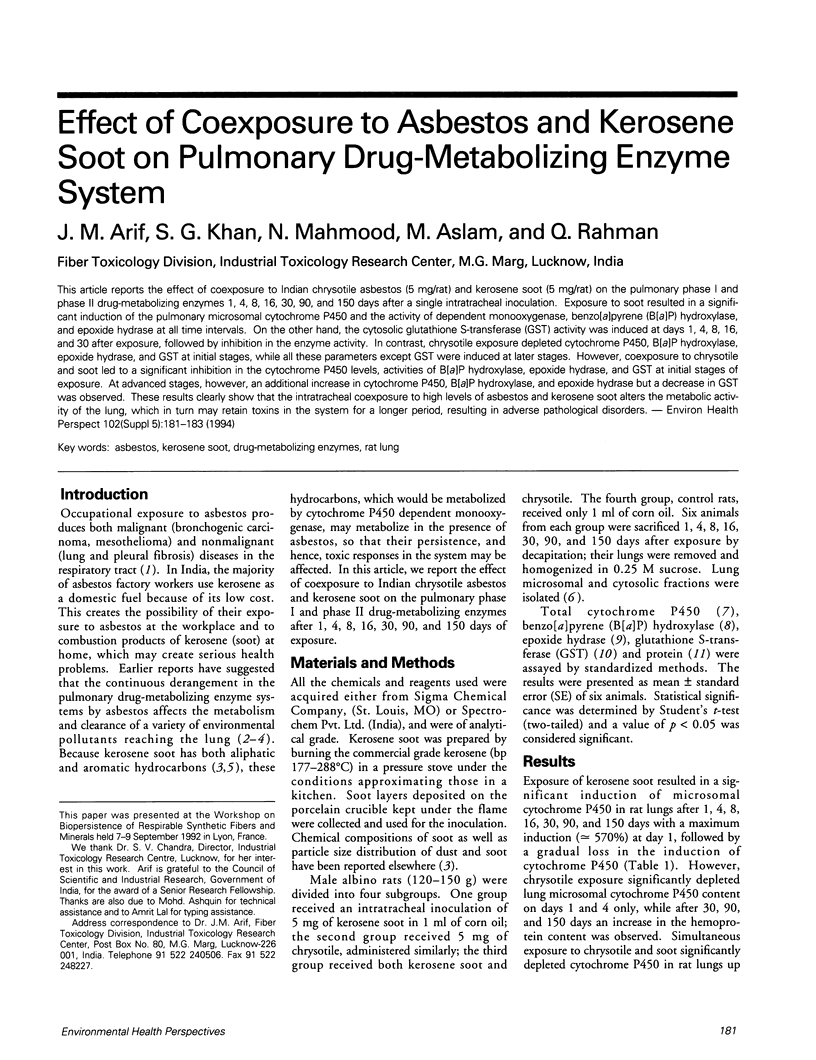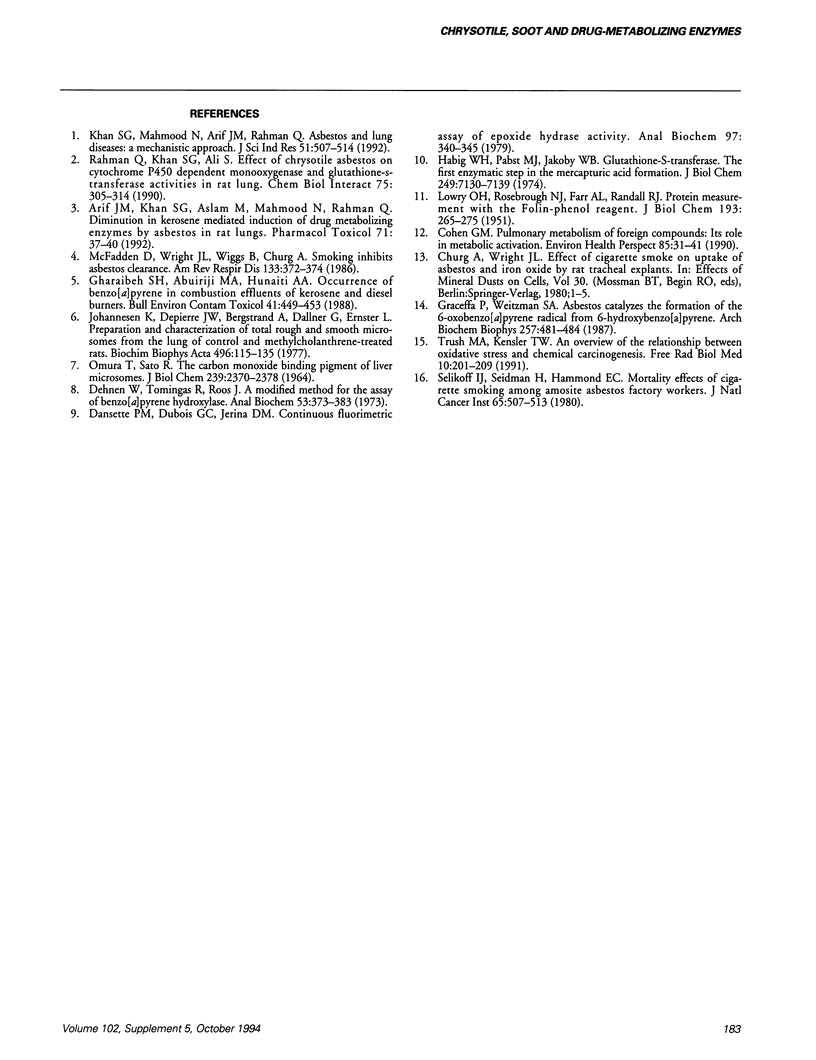Abstract
This article reports the effect of coexposure to Indian chrysotile asbestos (5 mg/rat) and kerosene soot (5 mg/rat) on the pulmonary phase I and phase II drug-metabolizing enzymes 1, 4, 8, 16, 30, 90, and 150 days after a single intratracheal inoculation. Exposure to soot resulted in a significant induction of the pulmonary microsomal cytochrome P450 and the activity of dependent monooxygenase, benzo(a)pyrene (B[a]P) hydroxylase, and epoxide hydrase at all time intervals. On the other hand, the cytosolic glutathione S-transferase (GST) activity was induced at days 1, 4, 8, 16, and 30 after exposure, followed by inhibition in the enzyme activity. In contrast, chrysotile exposure depleted cytochrome P450, B[a]P hydroxylase, epoxide hydrase, and GST at initial stages, while all these parameters except GST were induced at later stages. However, coexposure to chrysotile and soot led to a significant inhibition in the cytochrome P450 levels, activities of B[a]P hydroxylase, epoxide hydrase, and GST at initial stages of exposure. At advanced stages, however, an additional increase in cytochrome P450, B[a]P hydroxylase, and epoxide hydrase but a decrease in GST was observed. These results clearly show that the intratracheal coexposure to high levels of asbestos and kerosene soot alters the metabolic activity of the lung, which is turn may retain toxins in the system for a longer period, resulting in adverse pathological disorders.
Full text
PDF


Selected References
These references are in PubMed. This may not be the complete list of references from this article.
- Arif J. M., Khan S. G., Aslam M., Mahmood N., Rahman Q. Diminution in kerosene-mediated induction of drug metabolizing enzymes by asbestos in rat lungs. Pharmacol Toxicol. 1992 Jul;71(1):37–40. doi: 10.1111/j.1600-0773.1992.tb00517.x. [DOI] [PubMed] [Google Scholar]
- Cohen G. M. Pulmonary metabolism of foreign compounds: its role in metabolic activation. Environ Health Perspect. 1990 Apr;85:31–41. doi: 10.1289/ehp.85-1568313. [DOI] [PMC free article] [PubMed] [Google Scholar]
- Dansette P. M., DuBois G. C., Jerina D. M. Continous fluorometric assay of epoxide hydrase activity. Anal Biochem. 1979 Sep 1;97(2):340–345. doi: 10.1016/0003-2697(79)90083-6. [DOI] [PubMed] [Google Scholar]
- Dehnen W., Tomingas R., Roos J. A modified method for the assay of benzo(a)pyrene hydroxylase. Anal Biochem. 1973 Jun;53(2):373–383. doi: 10.1016/0003-2697(73)90083-3. [DOI] [PubMed] [Google Scholar]
- Gharaibeh S. H., Abuirjeie M. A., Hunaiti A. A. Occurrence of benzo[a]pyrene in combustion effluents of kerosene and diesel burners. Bull Environ Contam Toxicol. 1988 Sep;41(3):449–453. doi: 10.1007/BF01688892. [DOI] [PubMed] [Google Scholar]
- Graceffa P., Weitzman S. A. Asbestos catalyzes the formation of the 6-oxobenzo[a]pyrene radical from 6-hydroxybenzo[a]pyrene. Arch Biochem Biophys. 1987 Sep;257(2):481–484. doi: 10.1016/0003-9861(87)90594-7. [DOI] [PubMed] [Google Scholar]
- Habig W. H., Pabst M. J., Jakoby W. B. Glutathione S-transferases. The first enzymatic step in mercapturic acid formation. J Biol Chem. 1974 Nov 25;249(22):7130–7139. [PubMed] [Google Scholar]
- Johannesen K., Depierre J. W., Bergstrand A., Dallner G., Ernster L. Preparation and characterization of total, rough and smooth microsomes from the lung of control and methylcholanthrene-treated rats. Biochim Biophys Acta. 1977 Jan 24;496(1):115–135. doi: 10.1016/0304-4165(77)90120-9. [DOI] [PubMed] [Google Scholar]
- LOWRY O. H., ROSEBROUGH N. J., FARR A. L., RANDALL R. J. Protein measurement with the Folin phenol reagent. J Biol Chem. 1951 Nov;193(1):265–275. [PubMed] [Google Scholar]
- McFadden D., Wright J. L., Wiggs B., Churg A. Smoking inhibits asbestos clearance. Am Rev Respir Dis. 1986 Mar;133(3):372–374. doi: 10.1164/arrd.1986.133.3.372. [DOI] [PubMed] [Google Scholar]
- OMURA T., SATO R. THE CARBON MONOXIDE-BINDING PIGMENT OF LIVER MICROSOMES. I. EVIDENCE FOR ITS HEMOPROTEIN NATURE. J Biol Chem. 1964 Jul;239:2370–2378. [PubMed] [Google Scholar]
- Rahman Q., Khan S. G., Ali S. Effect of chrysotile asbestos on cytochrome P-450-dependent monooxygenase and glutathione-S-transferase activities in rat lung. Chem Biol Interact. 1990;75(3):305–313. doi: 10.1016/0009-2797(90)90073-v. [DOI] [PubMed] [Google Scholar]
- Selikoff I. J., Seidman H., Hammond E. C. Mortality effects of cigarette smoking among amosite asbestos factory workers. J Natl Cancer Inst. 1980 Sep;65(3):507–513. [PubMed] [Google Scholar]
- Trush M. A., Kensler T. W. An overview of the relationship between oxidative stress and chemical carcinogenesis. Free Radic Biol Med. 1991;10(3-4):201–209. doi: 10.1016/0891-5849(91)90077-g. [DOI] [PubMed] [Google Scholar]


